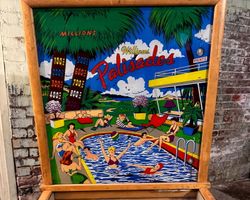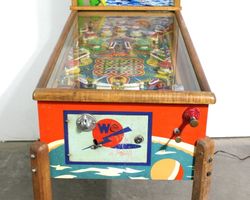Palisades

Average Prices: USD $300 to $800
Produced: July, 1953
Machine Type: Electro-mechanical
Players: 1
Design by: Harry Williams
Art by: George Molentin
The pinball machine "Palisades" emerged from the creative endeavors of Williams Electronic Games, Inc. in July 1953. This electro-mechanical (EM) machine, carrying the model number 87, represents a distinct period in pinball manufacturing when innovation was driven by mechanical ingenuity rather than digital programming. At its core, "Palisades" was a product of Harry Williams, who held a multifaceted role in its development. He was credited not only with the machine's overall design and concept but also with its mechanical underpinnings and even the animation elements. This comprehensive involvement from Harry Williams shaped the fundamental character of "Palisades." The visual identity of the machine was crafted by artist George Molentin, whose distinctive style brought the playfield and backglass to life with a vibrant aesthetic that characterized the era. Released during a time of widespread public interest in coin-operated amusement, "Palisades" found its place within arcades and other recreational venues. Its woodrail cabinet construction, typical of the period, added to its classic appeal, distinguishing it from later designs that transitioned to different cabinet materials.
Signature Features and Design
"Palisades" distinguishes itself through a blend of mechanical ingenuity and compelling visual design. At the heart of its gameplay are its flippers, which include not only two standard manual flippers but also two automatic flippers. These automatic flippers activate when the ball enters specific pockets directly in front of them, offering a dynamic and often surprising element to play. This design choice provided an early form of automated ball redirection, challenging players to adapt to an evolving playfield state. Complementing the flippers are two pop bumpers, which add to the kinetic energy of the playfield by sending the ball rebounding with unpredictable force.
The visual experience of "Palisades" is defined by George Molentin's artwork. His fantastic and colorful art from the 1950s captures a specific period aesthetic, lending the machine a vibrant and engaging look. This artwork is not merely decorative; it integrates seamlessly with the playfield's interactive elements, guiding the player's eye towards targets and scoring opportunities. The overall design embraces the classic woodrail cabinet, a hallmark of early EM machines, which contributes to its robust and enduring physical presence. The combination of these mechanical features and the period-specific artwork creates a cohesive and engaging machine that remains visually distinctive.
Playfield and Mechanics
The playfield of "Palisades" is a meticulously crafted layout designed to encourage varied shot-making and strategic play, characteristic of early electro-mechanical machines. Dominating the lower half are the two manual flippers, positioned to control the ball's trajectory up the field. Above them, two additional flippers are positioned to activate automatically when the ball falls into designated pockets, introducing a unique form of automated ball control. This unexpected redirection demands player adaptation, as the ball's path can suddenly change, leading to new scoring opportunities or unexpected drains.
Central to the playfield's interactive elements are two distinct kickout holes. One kickout hole propels the ball upwards onto the playfield, potentially setting up further shots or interacting with targets in the upper sections. The other kicks the ball downwards, often returning it to the lower flipper area or into the outlanes, adding an element of risk and reward to specific shots. The playfield is also populated with three star channels, which are lanes or rollovers that light up when the ball passes through them, contributing to specific scoring objectives. Additionally, a series of targets are marked with numbers 1 through 9, scattered across the playfield, requiring precise aiming to light them sequentially. Side special lanes also exist, offering further scoring avenues when activated. The artwork by George Molentin vividly portrays the machine's recreational theme, with bright colors and detailed illustrations that are aesthetically pleasing and visually guide the player. The lighting, typical of an EM machine, highlights activated targets and features, providing clear visual feedback as objectives are met. A center outlane adds a constant threat, demanding careful flipper control to avoid losing the ball. The design philosophy emphasizes a challenging flow, where precise shots are rewarded and multiple pathways to score are available, compelling players to master the unique interactions of its mechanical components.
Gameplay Dynamics
"Palisades" offers a gameplay experience deeply rooted in the mechanical precision and varied objectives of electro-mechanical pinball. The core scoring system involves accumulating points by hitting various targets, rollovers, and pop bumpers across the playfield, with progress tracked on mechanical reels. However, the game truly distinguishes itself through its multiple pathways to earning free games, adding layers of strategy and replayability beyond mere high scores.
Players are challenged to achieve specific objectives to secure these coveted replays. One primary objective involves lighting the three star channels and subsequently activating the side special lanes. Successfully navigating the ball through these specific pathways rewards the player with free games. Another distinct goal requires hitting the numbers 1 through 9 sequentially across the playfield, followed by lighting up the center outlane. This demands precise shot-making and a methodical approach to clearing each numbered target. The automatic flippers, a defining feature, can unexpectedly redirect the ball, sometimes assisting in hitting a desired target, and at other times sending the ball into an unforeseen trajectory, adding an element of unpredictability that keeps players engaged. The kickout holes further contribute to the dynamic, with one firing the ball up the field and another kicking it down, constantly altering the ball's momentum and position.
The ultimate achievement in "Palisades" is to complete both major objectives: making all three star channels and successfully lighting all numbers 1 through 9. If a player manages this feat across all five balls of a single game, the machine rewards them with five free games, a substantial bonus that elevates the challenge and satisfaction of a complete playthrough. This multi-layered objective system encourages players to strategize their shots, prioritizing specific targets based on their current game progression, and master the unique ball physics of this particular EM machine.
Reception and Legacy
"Palisades" generally receives positive feedback from the pinball community, often eliciting a strong sense of nostalgia from those who first encountered it in their formative years. Its strengths are frequently highlighted, particularly George Molentin’s artwork, which is consistently praised for its vibrant 1950s aesthetic and colorful appeal, contributing significantly to the machine's overall charm. The unique mechanical features, such as the actuated extra flippers and the impulse flippers, are often cited as engaging elements that enhance gameplay, providing moments of unexpected action and strategic depth. Reviewers also appreciate the varied gameplay experience, citing the multiple ways to earn free games—by score, by completing the star channels and side lanes, or by hitting the 1-9 numbers and lighting the center outlane. These diverse objectives contribute to a challenging and engaging experience that encourages players to return.
While the overwhelming sentiment is positive, some feedback suggests that "Palisades" may not offer the same level of high-octane excitement found in later, more feature-rich machines. However, this is often presented as a subjective observation rather than a significant flaw, with reviewers still affirming its enjoyment as "a treat to play." The machine's status as a unique and rare Williams woodrail from the EM era further elevates its appeal among collectors and enthusiasts, who value its historical significance and mechanical purity. "Palisades" holds a notable place in pinball history, not just as a well-regarded example of a 1950s electro-mechanical machine, but also for its role in sparking the interest of numerous individuals in the hobby. Its blend of straightforward objectives with a few innovative mechanical twists helped define the gameplay possibilities of its era, influencing subsequent Williams designs in terms of interactive playfield elements and objective-based scoring.
Sponsored Links
 Ebay Listings
Ebay Listings
 Auction Results
Auction Results
| Cost | Location | Date |
|---|---|---|
| USD $375 |  Maryland, United States Maryland, United States |
26 June, 2025 |
| USD $900 |  Ohio, United States Ohio, United States |
12 September, 2024 |
| USD $250 |  New York, United States New York, United States |
29 November, 2008 |


Private Policy · Search Website · Contact Us
As an eBay Partner, we may earn a commission from qualifying purchases made through links on this site, at no additional cost to you.
All trademarks and copyrighted materials remain property of their respective owners. All other content copyright 2007 - 2025 Pinpedia.


